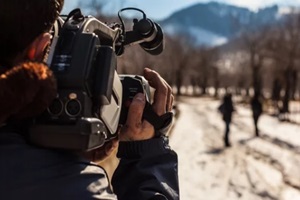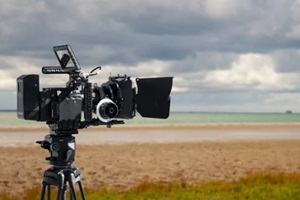 In the exciting world of documentary filmmaking, creators often find themselves in unpredictable and surprising situations. Whether your team is traveling to all corners of the world or capturing a story in their backyard, filmmakers can enjoy a sense of safety by securing insurance for their documentary production.
In the exciting world of documentary filmmaking, creators often find themselves in unpredictable and surprising situations. Whether your team is traveling to all corners of the world or capturing a story in their backyard, filmmakers can enjoy a sense of safety by securing insurance for their documentary production.
From protection for the cast, crew, and equipment to everything in between, robust insurance protection is non-negotiable for documentary teams.
Here is an overview of how documentary productions can protect themselves from unforeseen circumstances unique to the modern world.
The Hazards Of Filming Documentaries
One of the most appealing aspects of documentary filmmaking is its ability to create media covering topics and concerns not typically represented comprehensively in existing sources, such as blockbuster films or news reports.
However, the downside of this freedom is that documentary filmmakers may only partially benefit from the safety and financial security that more significant or mainstream projects enjoy.
Documentaries commonly portray stories that may take place in communities or areas that put the crew at risk, and the information contained within the documentary may trigger legal moves depending on its sensitivity and relevance.
Because of this, documentary production teams need to secure comprehensive insurance for their workers, equipment, and content.
Start a Documentary Risk Assessment for Insurance Coverage
The first step in deciding which types of insurance are most beneficial for a documentary is to conduct an assessment. How long will it take to finish the project?
How much time will be spent in public, and will public citizens be around or involved with the production? Is the equipment owned or being rented? Is the documentary being shot on public or rented/owned property?
Considering these aspects can help clarify which areas of production need insurance coverage.
Modern Tech Risks for Documentary Productions
In the modern age, documentaries are facing more challenges than ever before, and physical property is not the only thing that needs to be protected.
Cyber liability insurance has been growing in popularity because of the prevalence of hackers and issues related to artificial intelligence and online vulnerability.
This type of insurance offers protection against data theft and information mismanagement. Cyber liability insurance may cover replacement costs if a hard drive or memory card is lost or stolen.
Additionally, this type of insurance would cover legal fees for some modern types of lawsuits. A cyber-related lawsuit could arise from data breaches, stolen data, stolen media content, etc.
 However, cyber threats are not the only types of challenges that a documentary may face. Because of increasingly technological elements of documentary productions, such as high-fidelity equipment, 4K video capture, and more, teams face increased risks and higher costs when something goes wrong.
However, cyber threats are not the only types of challenges that a documentary may face. Because of increasingly technological elements of documentary productions, such as high-fidelity equipment, 4K video capture, and more, teams face increased risks and higher costs when something goes wrong.
For this reason, establishing a robust baseline of other insurance coverages is more critical than ever.
General Liability Insurance
The most basic level of insurance that documentaries typically need is general liability insurance. This protection is essential because it shields filmmakers from financial repercussions if someone uninvolved with the production becomes injured.
For instance, if a documentary was being shot in a local community center, suppose a child tripped and fell on an equipment cord. General liability insurance covers any medical costs that may result.
However, remember that this insurance does not apply to the cast and crew associated with the film production.
General liability insurance also offers protection in the case of damage to property belonging to a third party. Damage to third-party property could occur from human error to equipment malfunction.
Compensation for Workers and Talent
General liability insurance covers those not associated with the film production but does not offer coverage to the film’s cast and crew members.
Because of this, worker’s compensation insurance is an essential part of complete insurance coverage. The specifics of this coverage can vary widely based on factors such as location and production size.
The basics commonly include covering medical expenses if a cast or crew member becomes injured, compensation for any permanent injuries during shooting, and benefits for family members of any workers who pass away during the filming process.
Most states require a documentary production to demonstrate a minimum level of workers’ compensation coverage to acquire the permits necessary to film.
On-the-Go Insurance Coverage
Most documentaries will not be shot down the street from the production studio, so teams should expect to be out and about regularly—potentially even in different countries.
During this process, equipment is especially vulnerable to damage during transportation. Inland marine insurance is the most common method of protecting equipment during transit.
 While the specifics of an inland marine policy can vary, this insurance typically covers the movement/transportation of cameras, lighting equipment, computers and other electronics, props, wardrobe, and rented equipment.
While the specifics of an inland marine policy can vary, this insurance typically covers the movement/transportation of cameras, lighting equipment, computers and other electronics, props, wardrobe, and rented equipment.
It also sometimes covers trailers used to transport these items. The expensive filming equipment makes this insurance very valuable to filmmakers, who may otherwise be on the hook for tens of thousands in replacement costs.
Securing Your Documentary With Film Insurance From MFE
A comprehensive insurance plan is invaluable in the ever-evolving world of documentary filmmaking. Robust insurance can offer filmmakers a safety net to confidently pursue creative visions regardless of how technology continues to change and influence the filmmaking scene.
The experts at MFE Insurance can help you understand how tech continues to influence documentary production and secure insurance coverage to mitigate the risk. Contact MFE Insurance to discuss your options.
